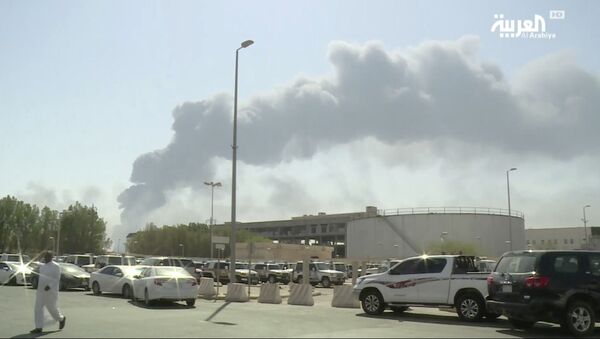A large collection of foreign unmanned aerial vehicles (UAVs) has been showcased in Tehran, at a display inaugurated by high-ranking military and government officials on Saturday. It will run from 22 September to October 7, Iran's state-run media reported.
The centrepiece of the exhibition, “Hunting Vultures”, was the debris of a heavy US surveillance drone, a RQ-4 Global Hawk which was downed in June.
The Iranians claim to have identified it as an advanced variant of the UAV MQ-4C Triton, although the US insists it was a prototype version of an RQ-4A drone, constructed during development of the Triton.
Iran also displayed the anti-aircraft system that is said to have brought it down, as well as the type of missiles used during the interception, with the Khordad-3 missile launcher displaying a kill mark for the downed US UAV.
#Iran#US MQ-4C Triton "Kill Mark" spotted on Sevom(3rd) Khordad Air Defense Systems.
— IWN (@A7_Mirza) September 21, 2019
Sevom(3rd) Khordad Air Defense System which succeeded in shot down the MQ-4C #Triton in the #StraitofHormuz on June 20, was exhibited on the occasion of Holy Defense Week in #Tehran. pic.twitter.com/BgkZV8mxjA
Another major exhibit is the US RQ-170 Sentinel that Iran intercepted intact back in 2011.
#Iran
— IWN (@A7_Mirza) September 21, 2019
More images:#US RQ-170 and the wreckages of US MQ-4C #Triton
/2 pic.twitter.com/UEsh5fqOmE
Another seemingly intact downed UAV appears to be a variant of an MQ-1 Predator. The interception of a machine of this type was reported back in 2016, with the details surrounding the event unclear.
#Iran
— IWN (@A7_Mirza) September 21, 2019
This morning, for the first time, #IRGC unveiled a collection of captured drones in an exhibition in #Tehran.
Images: US MQ-1, Israeli Hermes, US RQ-7, ScanEagle
/1 pic.twitter.com/ttEYjDeTyb
The display also offered a selection of smaller UAVs as well, appearing to include an Israeli Hermes drone, a US RQ-7 Shadow, a ScanEagle as well as several other light surveillance vehicles.
Drone attack on Saudi oil facilities
The display in Tehran came just a few days after Saudi Arabia showcased a large cache of military hardware it claimed to be the debris from Iranian-made drones and cruise missiles as Riyadh’s proof of “undeniable” Iranian involvement in the recent drone strike on Saudi oil-refining facilities.
On 14 September two drones targeted Saudi Arabia’s Aramco oil facilities, causing a major fire and partially disrupting oil production.
The incident was claimed by Yemen's Houthi rebels. Yemen has been engulfed in an armed conflict between the government forces led by President Abd Rabbuh Mansur Hadi and the Houthi rebels for several years, with the Saudi-led coalition carrying out airstrikes against the Houthis at Hadi's request since March 2015.
However, despite the announced claim of responsibility, Riyadh and Washington have put the blame on Iran.
Simmering US-Iran Tensions
Against the backdrop of recent developments in the volatile region, on 20 September the US announced plans to send some forces to Saudi Arabia and the United Arab Emirates.
According to US Defence Secretary Mark Esper, these troops will be defensive in nature. Esper added that the US does not seek war with Iran but "has other options" as well.
US President Donald Trump said he expected sanctions to "work" on Iran, adding that he preferred this strategy to one involving military action.
Speaking to reporters in the Oval Office, Trump claimed that sanctions would be the "highest...ever imposed on a country", going "right to the top" of the Iranian government.
Iran: hoping to avoid conflict, but ready for "all-out-war"
As Tehran has been vehemently rejecting all accusations of its complicity in the drone attack on Saudi oil facilities, Iranian Foreign Minister Javad Zarif said in an interview Friday that he hoped to avoid conflict.
Nevertheless, he said Iran was prepared for “all-out war” in the event of an attack by Saudi or US forces, asking whether Saudi Arabia was ready to fight “to the last American soldier.”
Major General Hossein Salami, the chief of the elite Islamic Revolutionary Guard Corps (IRGC), which the US has recently designated as a terrorist group, also warned that any nation that attacks Iran will promptly become the “main battlefield” for such a conflict, adding that Tehran is ready to fight “until the full destruction of any aggressor.”
Earlier this week, the US administration ordered new economic sanctions against Iran, targeting the country's central bank and its sovereign wealth fund, with the Iranian Foreign Minister Javad Zarif describing the new sanctions as "unacceptable and dangerous".
“This is a sign of US desperation ... When they repeatedly sanction the same institution, this means their attempt at bringing the Iranian nation to its knees under 'maximum pressure has failed,” Zarif told state television.




